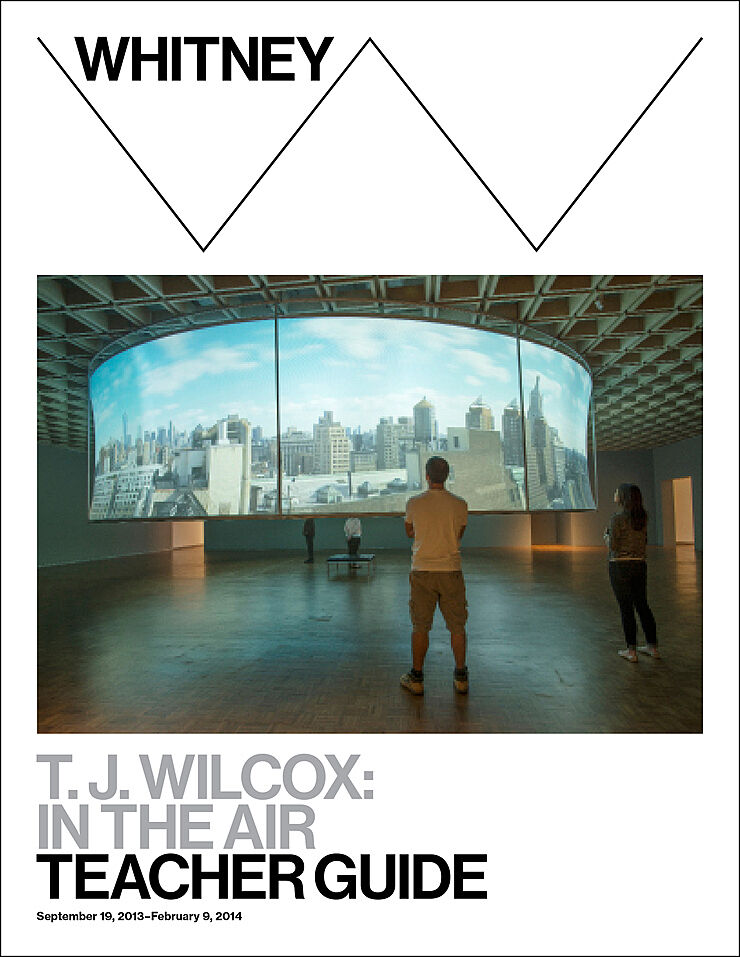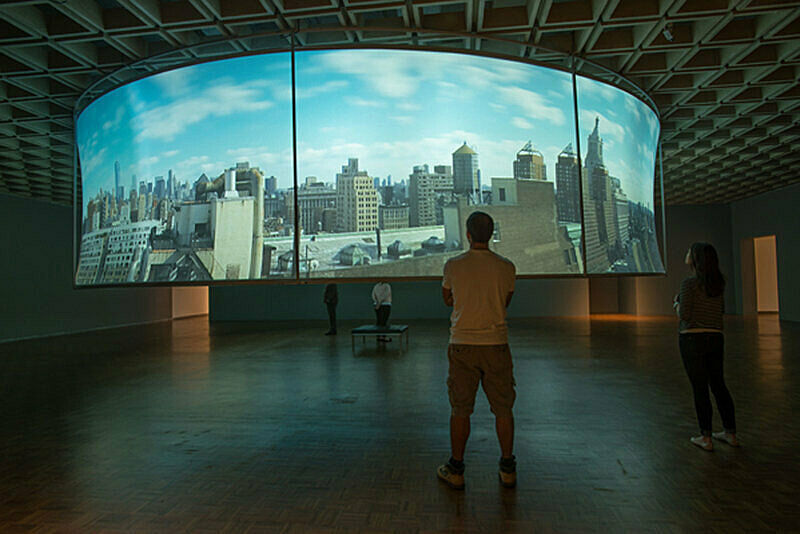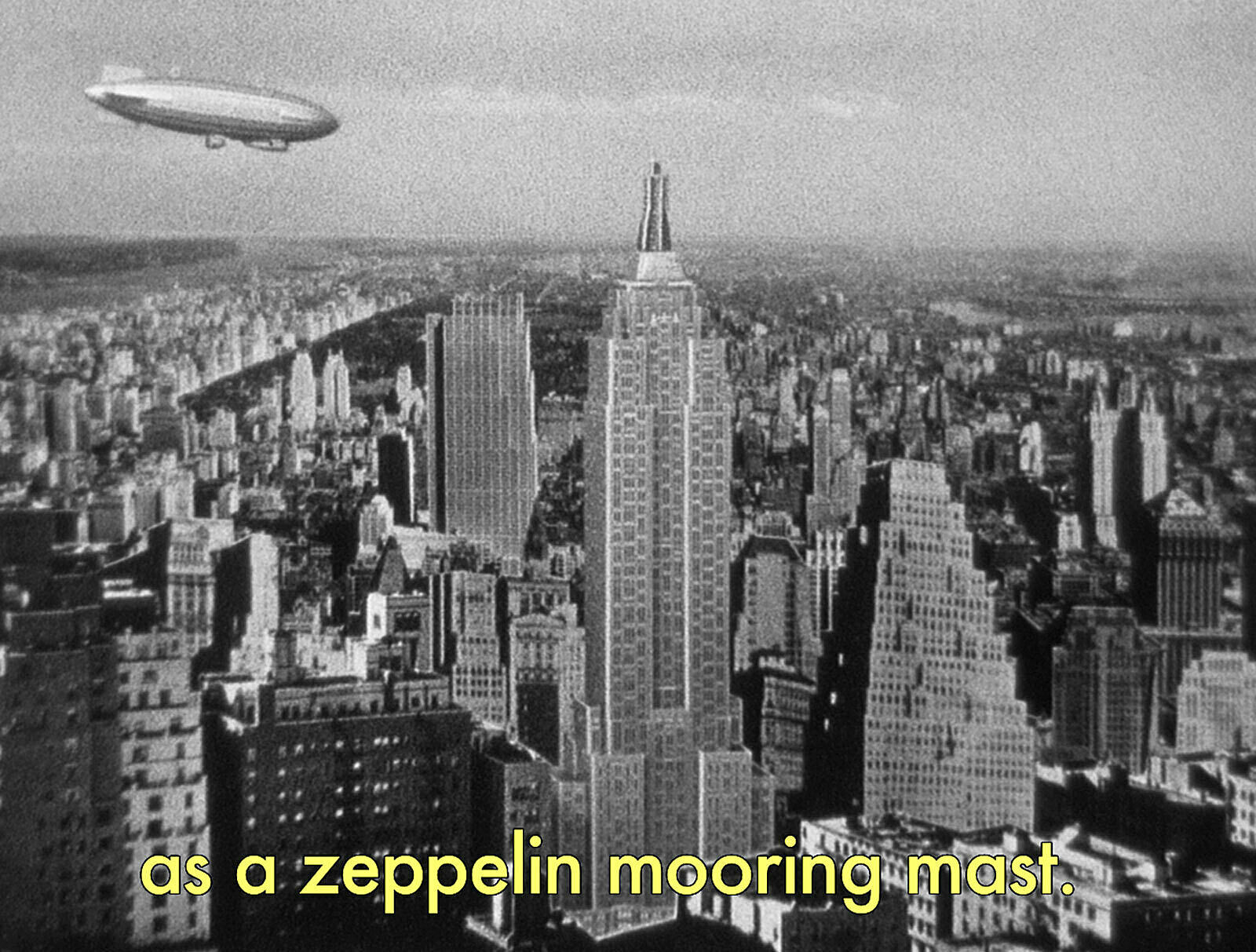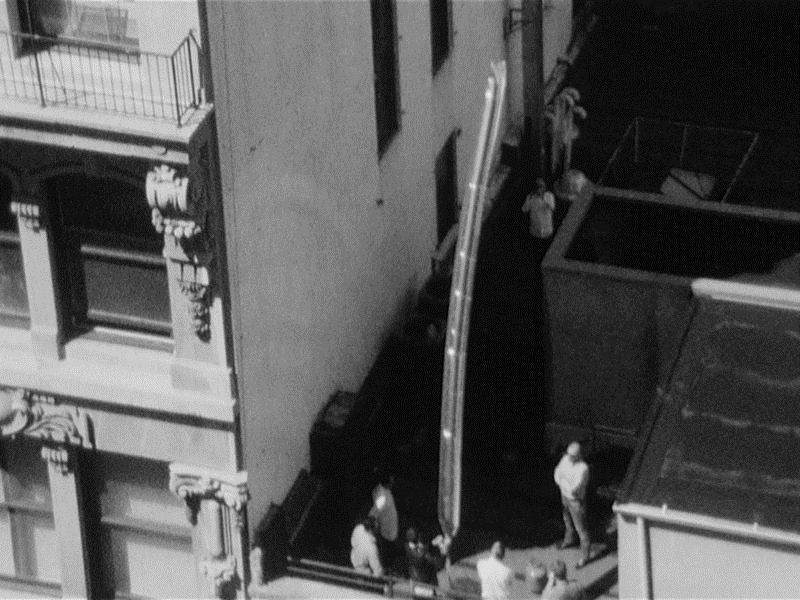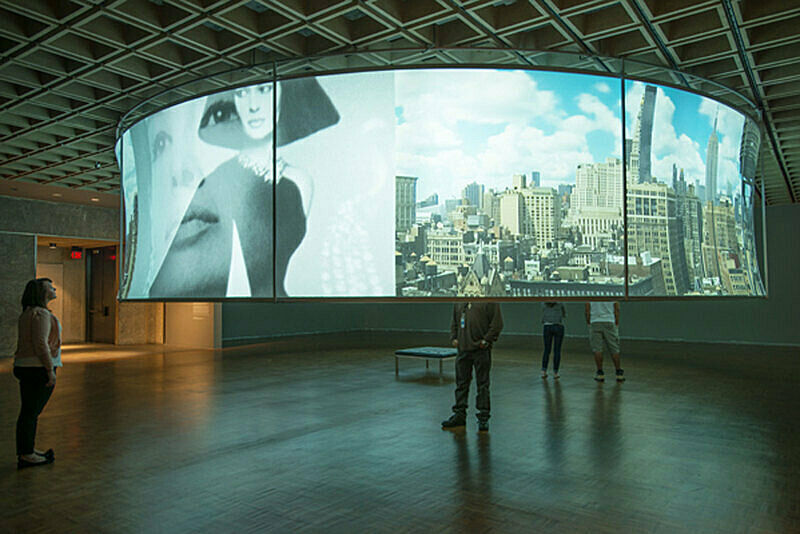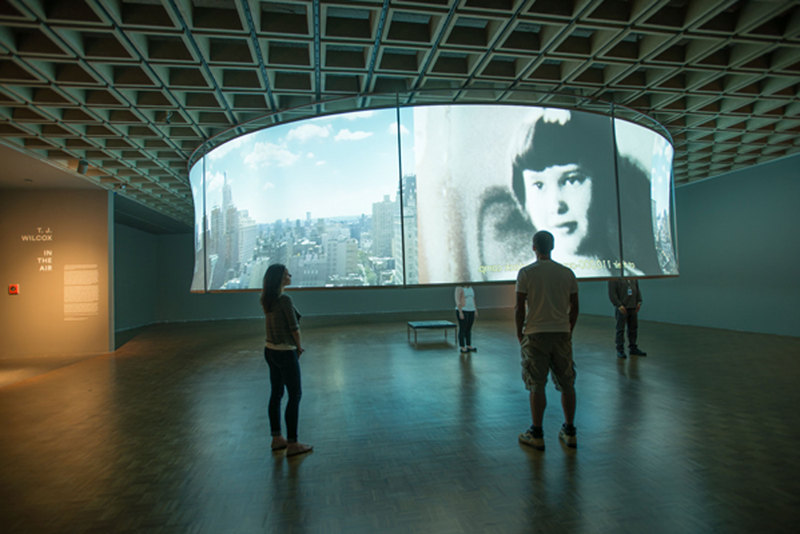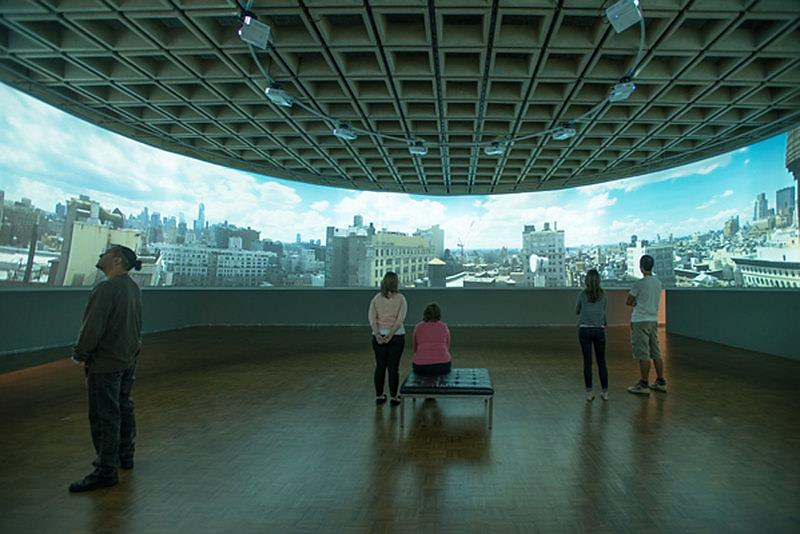Teacher Guide:
T. J. Wilcox: In the Air
Sep 19, 2013
About this guide
1. How can these materials be used?
These materials provide a framework for preparing you and your students for a visit to the exhibition and offer suggestions for follow up classroom reflection and lessons. The discussions and activities introduce some of the exhibition’s key themes and concepts.
2. Which grade levels are these materials intended for?
These lessons and activities have been written for Elementary, Middle, or High School students. We encourage you to adapt and build upon them in order to meet your teaching objectives and students’ needs.
3. Learning standards
The projects and activities in these curriculum materials address national and state learning standards for the arts, English language arts, social studies, and technology.
4. Feedback
Please let us know what you think of these materials. How did you use them? What worked or didn’t work? Email us at schoolprograms@whitney.org.
About this Exhibition
T.J. WILCOX: IN THE AIR, 2013
New York-based artist T. J. Wilcox has long been fascinated by the idea that history is always under construction. His poetic films collage fact, fiction, myth, memory, and fantasy, creating vignettes that infuse the immersive spectacle of cinema with the intimacy of a short story. With In the Air, the artist revisits the “cinema-in-the-round” presentations that were popular in film’s infancy at the end of the nineteenth century, updating the concept with state-of-the-art technology. Filmed from the artist’s studio high above Union Square, In the Air initially presents a spectacular, 360-degree bird’s-eye view of New York City from dawn until dusk. The speed of the footage has been increased so that the day is compressed into one half hour, greatly exaggerating the light and shadow effects of the sun as it passes over the city.
One by one, six of the projectors cut away to present stories inspired by a particular view from the studio. In one film, a stop-motion animation using archival footage of the Empire State Building, Wilcox reimagines the architect’s original plan to use the mast of the building as a landing site for trans-Atlantic zeppelins.
Interweaving historic images of one of the most iconic buildings in the world with those of its visionary yet unrealized past, Wilcox’s own daily view of it, and his fantasy of what might have been, the artist pays tribute to the New York City of forward-thinking dreamers. The remaining five films similarly elaborate on uniquely New York stories. They include a re-creation of Andy Warhol’s launch of a long silver balloon from the roof of his Factory on East 47th Street as Pope Paul VI’s motorcade passed by in 1965; an homage to artist, heiress, and socialite Gloria Vanderbilt, perhaps the first “celebrity” to be stalked by the media in a manner so common today; a tribute to the 1980s fashion illustrator Antonio, whose work inspired Wilcox before he moved to New York and whose life ended tragically early of complications from AIDS; and an interview with the superintendent of Wilcox’s studio building, focusing on his firsthand account of the events of the morning of September 11, 2001.
The final film depicts the “Manhattan-henge” phenomenon, a biannual event when the sunset is perfectly framed by the canyon-like walls of the city’s major east-west streets. In the Air articulates how personal memory, historical record, family lore, and political, social, national, and artistic narratives and mythologies all collide to produce our collective experience of places and events.
Wilcox has said, “I like my film and video work to appear as the visible record of my own journey through our saturated mediated age, highlighting those things that have held my attention and captured my imagination. Just as our perception of a present is a hybrid of personal memory, historical record, family lore, political, social, national, and artistic histories and mythologies, film and video provide the page upon which I make a collage of the ideas I hold most dear.”
The installation is accompanied by a display of related works selected by Wilcox from the Museum’s collection, presented in the back galleries. Each work articulates a different experience of looking ¾ up, down, around, and across. Wilcox has also selected a group of films and videos from the collection that explore filmmakers’ and artists’ perspectives of the cityscape of New York from the 1950s to the recent past. The films are shown daily in the Kaufman Astoria Film Studios Film & Video Gallery.
T. J. Wilcox: In the Air is organized by Chrissie Iles, Anne and Joel Ehrenkranz Curator.
About the Artist
T. J. WILCOX (B. 1965)
Born in Seattle, Washington, T.J. Wilcox became interested in European history as a child and made an animated Super-8 film in his fifth-grade art class. In 1983 he moved to New York to study at the School of Visual Arts where he received his BFA in 1989. He received his MFA in 1995 from the Art Center College of Design in Pasadena, California. Wilcox was originally a painter, but in graduate school he became more interested in film: ". . .the sense of being surrounded by the film industry affected me. . .I had been a painter and I approached my films from that perspective—I was interested in the palette of colors film offered, composing the frame, creating layers of information. . .also film’s ability to contain and reveal so much information simultaneously. . .I wasn’t able to accomplish this through painting. You can approach a story from its official history, or from its history in a popular magazine, and then from rumored passed on history.”
Wilcox has made several films based on famous figures from history and pop culture. In 1996, he moved back to New York and produced The Escape (of Marie Antoinette) (1996). In this 12-minute film, he includes drawings of her carriage from historical footage of a procession around Notre Dame, short scenes from 1950s American melodramas, and images of an early 1990s model on a catwalk. These images are unified through subtitles in which he reinvents the French queen’s history.
Wilcox’s process involves shooting the films on Super-8 film. The films are then transferred to video for editing, and finally printed onto 16mm film for projection. Because of the transfers, the films colors shift, causing them to attain a grainy, worn texture. During post-production, segments of the film are cut and collaged. Wilcox arranges and rearranges units of meaning, divorcing bits of film from their original narrative and recombining them anew. The continuous layering increases the density of the film, collapsing the distinctions between fact and fiction, objectivity and subjectivity, biography and autobiography.
For In the Air (2013), Wilcox changed his process. He switched from filming to shooting stills, which improved the resolution. He downgraded his equipment from five complex cameras to ten relatively small, rugged GoPro cameras to photograph the New York City panorama at a rate of one photograph per second. The resulting 60,000 photographs were individually processed, and then animated and sped up, using a computer program that seamlessly stitched the images together, eliminating distortions and making light levels more even.
Wilcox’s films are often silent and subtitled. They are projected in the gallery space, accompanied only by the whirring sound of the 16mm film projector. The short distance between the projected image and its source activates the space between, creating an almost sculptural, three-dimensional experience. In addition, Wilcox often exhibits collaged photographed images relating to the videos. In the Air marks Wilcox’s third showing at the Whitney, after earlier inclusions in the 2004 and 1997 Biennial exhibitions.
Anne Collier, “Interview with TJ Wilcox,” BOMB, Issue 11 Spring 2010. http://bombsite.com/issues/111/articles/3453
Consulted October 15, 2013.
Pre-visit Activities
Before visiting the Whitney, we recommend that you and your students explore and discuss some of the ideas and themes in the exhibition T.J. Wilcox: In the Air.
Objectives:
Introduce students to the work of artist T.J. Wilcox.
Introduce students to the themes they may encounter on their museum visit such as “Artist as Observer” and “Artist as Experimenter.”
Make connections to the artist’s sources of inspiration including New York City.
Explore how T. J. Wilcox examines complex social and political issues in his work.
Artist as Observer
T. J. WILCOX, PLACE AND MEMORY
“I would remember anecdotes, stories, histories, sort of relating to each part of the city that I was looking at. I became really interested in this idea that I was seeing the view in the present tense as I was looking at the New York cityscape, but that I was also looking across time. There’s that corner where you broke up with your girlfriend, and there’s a location that was the backdrop in a Sex in the City episode you saw ten years ago. And I wanted to make a film that could include all these things—A sort of sense that I think we all have looking at New York City—of seeing it in the past and present simultaneously.”
—T. J. Wilcox
Read the quotation above by T. J. Wilcox with your students. What are the places that they walk by in their everyday lives? What memories or associations do these places conjure up for your students? Ask students to think of a place that suggests a personal story from their past. Have students write the story or make a drawing of it and share their writing or drawing with the class. How do students’ stories relate to their current lives?
ARTIST AS STORYTELLER
HOMETOWN STORY
In addition to a 360-degree panorama of the city, T. J. Wilcox presents six uniquely New York stories, each inspired by a particular view from his studio. Ask your class to discuss the following: if there was one story about their hometown that they would like to share, what would it be? Is it a story about a place, a person, a group of people, an event, a natural phenomenon? A combination of these? Something else? Why would students want to share the story with the rest of the world?
Ask your students to divide into small groups and write the (same) story in their own words. Depending on what the story is, they could do research and/or interview family or community members. Share and compare students’ stories. How are they similar or different? From what perspectives did students choose to tell the same story?
Post-visit Activities
Objectives
Enable students to reflect upon and further discuss some of the ideas and themes from the exhibition T. J. Wilcox: In the Air.
Have students further explore some of the artist’s approaches through art-making and writing activities.
Ask students to reflect upon what inspires them when they create works of art.
Artist as Experimenter
CONTINUOUS MURAL
T. J. Wilcox used his imagination and state of the art technology to create his panorama of New York City. Ask students to find and/or draw images of the place where they live and experiment with creating a collaborative, continuous mural of their environment. If exact images are not available, find images in magazines, newspapers, or other ephemera such as brochures, pamphlets, or maps that would represent a park, rooftops, sky, etc. Students can layer and/or overlap images and drawings so that they form a single cityscape or landscape. If students are drawing, they may want to go outside, form a circle facing outward, and draw what they see from their perspective.
What types of images appear in their mural? What types of drawn images were included? Are there images of shared space, such as parks? Were any aspects of their environment repeated or found in more than one place in the mural? Why do students think that may have occurred?
Ask younger students to draw the street where they live or where their school is. What did they include and/or leave out? What is special about their street?
Artist as Experimenter
VIDEO STORY
Ask students to use a video app such as Vine to make a short digital video of the story about their hometown from pre-visit activity “Hometown Story.” Divide students into small groups. Ask them to write a script or storyboard for their video. Have them act out the story if it includes people, or do voiceover if not.
ARTIST AS STORYTELLER
WHAT HAPPENS INSIDE?
Ask students to choose one building or enclosed structure from their collaborative continuous mural and imagine what might happen inside. Make a drawing of the scene. Write a short story about what is happening in the drawing. Share with class. What images and stories did they come up with? Were their stories based on reality or fiction?
Bibliography and links
T. J. Wilcox exhibition.
http://prod-images.exhibit-e.com/www_metropicturesgallery_com/TJW_Frieze_2013_SEND0.pdf
Bell, Kirsty. “Sunrise to Sunset,” Frieze, September 2013, 114-119.
http://bombsite.com/issues/111/articles/3453
Collier, Anne. “T. J. Wilcox,” Bomb, Spring 2010, 78-85.
http://www.interviewmagazine.com/art/tj-wilcox
Peyton, Elizabeth. “T.J. Wilcox,” Interview, September 2013, 158-163, 339-340.
http://prod-images.exhibit-e.com/www_metropicturesgallery_com/TJW_AIA_2013_SEND.pdf
Wilcox, T.J. “Careful Looking,” Art in America, September 60-61.
http://www.metropicturesgallery.com/artists/t-j-wilcox/
Information and articles about T.J. Wilcox.
A site for creating online books.
A content-sharing site that allows members to “pin” images, videos, and other objects to their virtual pinboard.
A user-friendly micro-blogging platform for posting multimedia content.
Twitter is a free social networking and micro-blogging service where users send and read each other’s updates, known as tweets—text-based posts of up to 140 characters, displayed on the author’s profile page and delivered to other users—known as followers—who have subscribed to them.
Credits
This Teacher Guide was prepared by Dina Helal, Manager of Education Resources; Lisa Libicki, Whitney Educator; Heather Maxson, Manager of School, Youth, and Family Programs; and Ai Wee Seow, Coordinator of School and Educator Programs.
T. J. Wilcox: In the Air is sponsored by Pamella Roland.
Generous support is provided by the Daniel and Pamella DeVos Foundation and the National Committee of the Whitney Museum of American Art.
Additional support is provided by Jennifer McSweeney.
The Whitney Museum of American Art’s School and Educator Programs are made possible by endowments from the William Randolph Hearst Foundation and the Walter and Leonore Annenberg Fund.
Additional support is provided by Con Edison, public funds from the New York City Department of Cultural Affairs in partnership with the City Council, and by members of the Whitney’s Education Committee.
Free Guided Student Visits for New York City Public and Charter Schools endowed by the Allen and Kelli Questrom Foundation.

